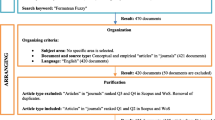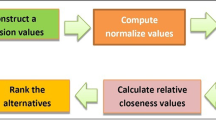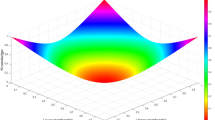Abstract
Correlation coefficient (CC) is a reliable information measure for measuring interrelationship between Pythagorean fuzzy sets (PFSs). Some approaches for calculating CC of PFSs have been considered. These hitherto approaches assess only the strength of relationship between PFSs, and are described within the interval [0,1]. This paper proposes a three-way approach for the computation of CC between PFSs by using the concepts of variance and covariance, respectively. This new approach is defined within the interval [− 1,1] akin to classical statistics, shows the strength of relationship between the considered PFSs and indicates whether the PFSs are either positively or negatively correlated. By including the three conventional parameters of PFSs in the proposed technique, the possibility of error due to information leakage is reasonably minimized. The new technique is validated with some theoretical results to show its suitability as reliable information measure. Some numerical examples are considered to show the edges of the new methods over similar methods. From the comparative analysis, the proposed methods of computing CCPFSs give more reliable and reasonable results compare to similar existing methods as presented in Table 13. Certain decision-making problems involving recognition of patterns and diagnostic medicine are resolved with the aid of the new method. The three-way technique of computing correlation coefficient between PFSs can solve decision-making problems that are multi-attributes in nature.
Similar content being viewed by others
References
Zadeh L A (1965) Fuzzy sets. Inf Control 8:338–353
Atanassov K T (1986) Intuitionistic fuzzy sets. Fuzzy Set Syst 20:87–96
Hatzimichailidis A G, Papakostas A G, Kaburlasos V G (2012) A novel distance measure of intuitionistic fuzzy sets and its application to pattern recognition problems. Int J Intell Syst 27:396–409
Wang W, Xin X (2005) Distance measure between intuitionistic fuzzy sets. Pattern Recog Lett 26:2063–2069
Boran F E, Akay D (2014) A biparametric similarity measure on intuitionistic fuzzy sets with applications to pattern recognition. Inf Sci 255(10):45–57
Xu S, Chen J, Wu J J (2008) Cluster algorithm for intuitionistic fuzzy sets. Inf Sci 178:3775–3790
De S K, Biswas R, Roy A R (2001) An application of intuitionistic fuzzy sets in medical diagnosis. Fuzzy Set Syst 117(2):209–213
Ejegwa P A, Onyeke I C (2021) A robust weighted distance measure and its applications in decision making via Pythagorean fuzzy information. J Inst Elect Comput 3:87–97
Liu P, Chen S M (2017) Group decision making based on Heronian aggregation operators of intuitionistic fuzzy numbers. IEEE Trans Cybern 47(9):2514–2530
Szmidt E, Kacprzyk J (2001) Intuitionistic fuzzy sets in some medical applications. Note IFS 7(4):58–64
Szmidt E, Kacprzyk J (2004) Medical diagnostic reasoning using a similarity measure for intuitionistic fuzzy sets. Note IFS 10(4):61–69
Tirkolaee E B, Mardani A, Dashtian Z, Soltani M, Weber G W (2020) A novel hybrid method using fuzzy decision making and multi-objective programming for sustainable-reliable supplier selection in two-echelon supply chain design. J Cleaner Prod 250:119517
Tirkolaee E B, Mahdavi I, Esfahani M M S, Weber G W (2020) A robust green location-allocation-inventory problem to design an urban waste management system under uncertainty. Waste Manag 102:340–350
Goli A, Tirkolaee E B, Malmir B, Bian G B, Sangaiah A K (2019) A multi-objective invasive weed optimization algorithm for robust aggregate production planning under uncertain seasonal demand. Comput 101:499–529
Goli A, Tirkolaee E B, Aydin N S (2021) Fuzzy integrated cell formation and production scheduling considering automated guided vehicles and human factors. IEEE Trans Fuzzy Syst 29(12):3686–3695
Haseli G, Sheikh R, Wang J, Tomaskova H, Tirkolaee E B (2021) A novel approach for group decision making based on the best-worst method (G-bwm): Application to supply chain management. Math 9 (16):1881
Pahlevan S M, Hosseini SMS, Goli A (2021) Sustainable supply chain network design using products’ life cycle in the aluminum industry. Environ Sci Pollut Res. https://doi.org/10.1007/s11356-020-12150-8https://doi.org/10.1007/s11356-020-12150-8
Tirkolaee E B, Mahdavi I, Esfahani M M S, Weber G W (2019) A robust green location-allocation-inventory problem to design an urban waste management system under uncertainty. Waste Manag 1(102):340–350
Tirkolaee EB, Abbasian P, Weber GW (2020) Sustainable fuzzy multi-trip location-routing problem for medical waste management during the COVID-19 outbreak. Sci Total Environ 20(756):143607
Chiang D A, Lin N P (1999) Correlation of fuzzy sets. Fuzzy Set Syst 102(2):221–226
Dumitrescu D (1978) Fuzzy correlation. Studia Univ Babes-Bolyai Math 23:41–44
Murthy C A, Pal S K, Majumder D D (1985) Correlation between two fuzzy membership functions. Fuzzy Set Syst 17:23–38
Yu C (1993) Correlation of fuzzy numbers. Fuzzy Set Syst 55:303–307
Gerstenkorn T, Manko J (1991) Correlation of intuitionistic fuzzy sets. Fuzzy Set Syst 44 (1):39–43
Hong D H, Hwang S Y (1995) Correlation of intuitionistic fuzzy sets in probability spaces. Fuzzy Set Syst 75:77–81
Hung W L (2001) Using statistical viewpoint in developing correlation of intuitionistic fuzzy sets. Int J Uncert Fuzz Knowl-Based Syst 9(4):509–516
Hung W L, Wu J W (2002) Correlation of intuitionistic fuzzy sets by centroid method. Inf Sci 144(1):219–225
Mitchell H B (2004) A correlation coefficient for intuitionistic fuzzy sets. Int J Intell Syst 19 (5):483–490
Zeng W, Li H (2007) Correlation coefficient of intuitionistic fuzzy sets. J Indust Eng Int 3 (5):33–40
Liu B, Shen Y, Mu L, Chen X, Chen L (2016) A new correlation measure of the intuitionistic fuzzy sets. J Intell Fuzzy Syst 30(2):1019–1028
Thao N X, Ali M, Smarandache F (2019) An intuitionistic fuzzy clustering algorithm based on a new correlation coefficient with application in medical diagnosis. J Intell Fuzzy Syst 36(1):189–198
Garg H, Kumar K (2018) A novel correlation coefficient of intuitionistic fuzzy sets based on the connection number of set pair analysis and its application. Scientia Iranica 25(4):2373–2388
Garg H (2018) Novel correlation coefficients under the intuitionistic multiplicative environment and their applications to decision-making process. J Indust Manag Optim 14(4):1501–1519
Garg H, Rani D (2019) A robust correlation coefficient measure of complex intuitionistic fuzzy sets and their applications in decision-making. Appl Intell 49:496–512
Garg H, Arora R (2020) TOPSIS Method based on correlation coefficient for solving decision-making problems with intuitionistic fuzzy soft set information. AIMS Math 5(4):2944–2966
Ejegwa P A, Onyeke I C (2021) Intuitionistic fuzzy statistical correlation algorithm with applications to multi-criteria based decision-making processes. Int J Intell Syst 36(3):1386–1407
Thao N X (2018) A new correlation coefficient of the intuitionistic fuzzy sets and its application. J Intell Fuzzy Syst 35(2):1959– 1968
Park J H, Lim K M, Park J S, Kwun Y C (2009) Correlation coefficient between intuitionistic fuzzy sets. In: Cao B., Li T. F., Zhang C Y (eds) Fuzzy information and engineering volume 2 (2009), AISC, vol 62. Springer, Berlin, pp 601–610
Szmidt E, Kacprzyk J (2010) Hoffmann Correlation of intuitionistic fuzzy sets. In: Hullermeier E, Kruse R (eds) IPMU 2010, LNAI, vol 6178. Springer, Berlin, pp 169–177
Xu Z, et al. (2006) On correlation measures of intuitionistic fuzzy sets. In: Corchado E (ed) IDEAL 2006, LNCS, vol 4224. Springer, Berlin, Heidelberg, pp 16–24
Atanassov KT (1989) Geometrical interpretation of the elements of the intuitionistic fuzzy objects. Preprint IM-MFAIS-1-89, Sofia
Yager R R (2013) Pythagorean membership grades in multicriteria decision making. Technical Report MII-3301 Machine Intelligence Institute Iona College, New Rochelle
Yager R R, Abbasov A M (2016) Pythagorean membership grades, complex numbers and decision making. J Intell Fuzzy Syst 28(5):436–452
Ejegwa P A (2018) Distance and similarity measures for Pythagorean fuzzy sets. Granul Comput 5(2):225–238
Yager R R (2016) Properties and applications of Pythagorean fuzzy sets. Springer, Berlin
Ejegwa P A (2019) Pythagorean fuzzy set and its application in career placements based on academic performance using max-min-max composition. Complex Intell Syst 5:165–175
Ejegwa P A (2019) Improved composite relation for Pythagorean fuzzy sets and its application to medical diagnosis. Granul Comput 5(2):277–286
Yager R R (2014) Pythagorean membership grades in multicriteria decision making. IEEE Trans Fuzzy Syst 22(4):958–965
Zhang X (2016) A novel approach based on similarity measure for Pythagorean fuzzy multiple criteria group decision making. Int J Intell Syst 31:593–611
Ejegwa P A (2020) Modified Zhang and Xu’s distance measure of Pythagorean fuzzy sets and its application to pattern recognition problems. Neural Comput Appl 32(14):10199–10208
Ejegwa P A, Awolola J A (2021) Novel distance measures for Pythagorean fuzzy sets with applications to pattern recognition problems. Granul Comput 6:181–189
Zhang X L, Xu Z S (2014) Extension of TOPSIS to multiple criteria decision making with Pythagorean fuzzy sets. Int J Intell Syst 29(12):1061–1078
Ejegwa P A, Wen S, Feng Y, Zhang W, Tang N (2021) Novel Pythagorean fuzzy correlation measures via Pythagorean fuzzy deviation, variance and covariance with applications to pattern recognition and career placement. IEEE Trans Fuzzy Syst. https://doi.org/10.1109/TFUZZ.2021.3063794https://doi.org/10.1109/TFUZZ.2021.3063794
Zeng W, Li D, Yin Q (2018) Distance and similarity measures of Pythagorean fuzzy sets and their applications to multiple criteria group decision making. Int J Intell Syst 33(11):2236–2254
Garg H (2016) A novel correlation coefficients between Pythagorean fuzzy sets and its applications to decision making processes. Int J Intell Syst 31(12):1234–1252
Thao N X (2020) A new correlation coefficient of the Pythagorean fuzzy sets and its applications. Soft Comput 24:9467–9478
Singh S, Ganie A H (2020) On some correlation coefficients in Pythagorean fuzzy environment with applications. Int J Intell Syst 35(4):682–717
Ejegwa P A (2021) Generalized triparametric correlation coefficient for Pythagorean fuzzy sets with application to MCDM problems. Granul Comput 6(3):557–566
Ejegwa P A, Adah V, Onyeke IC (2021) Some modified Pythagorean fuzzy correlation measures with application in determining some selected decision-making problems. Granul Comput. https://doi.org/10.1007/s41066-021-00272-4https://doi.org/10.1007/s41066-021-00272-4
Ejegwa P A, Onyeke I C, Adah V (2021) A Pythagorean fuzzy algorithm embedded with a new correlation measure and its application in diagnostic processes. Granul Comput 6:1037–1046
Acknowledgements
This work is supported by the Foundations of Chongqing Municipal Key Laboratory of Institutions of Higher Education ([2017]3), Chongqing Development and Reform Commission (2017[1007]), and Chongqing Three Gorges University.cle.
Author information
Authors and Affiliations
Corresponding author
Ethics declarations
Conflict of Interests
The authors declare that there is no conflict of interest regarding the publication of the article.
Additional information
Publisher’s note
Springer Nature remains neutral with regard to jurisdictional claims in published maps and institutional affiliations.
Rights and permissions
About this article
Cite this article
Ejegwa, P.A., Wen, S., Feng, Y. et al. A three-way Pythagorean fuzzy correlation coefficient approach and its applications in deciding some real-life problems. Appl Intell 53, 226–237 (2023). https://doi.org/10.1007/s10489-022-03415-5
Accepted:
Published:
Issue Date:
DOI: https://doi.org/10.1007/s10489-022-03415-5




